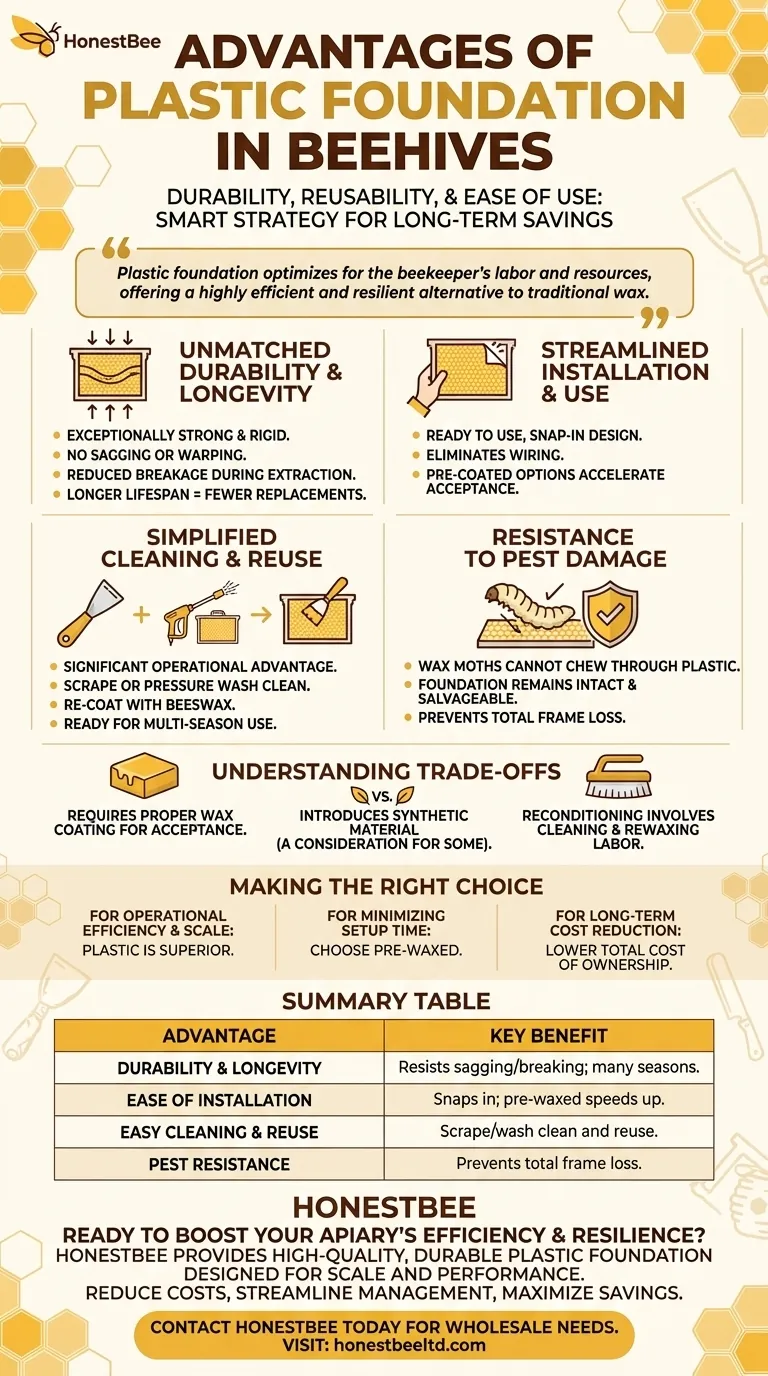In short, the primary advantages of plastic foundation are durability, reusability, and ease of use. This combination leads to significant long-term savings in both time and money for the beekeeper. Unlike traditional beeswax foundation, plastic is rigid, resistant to pest damage, and can be cleaned and redeployed in the hive for many seasons.
Choosing foundation isn't just about giving bees a guide; it's a strategic decision that impacts your entire workflow. Plastic foundation optimizes for the beekeeper's labor and resources, offering a highly efficient and resilient alternative to traditional wax.

The Core Advantages of Plastic Foundation
Plastic foundation's benefits center on creating a more durable and manageable system for the beekeeper. It directly addresses common points of failure and labor associated with beeswax foundation.
Unmatched Durability and Longevity
Plastic foundation is exceptionally strong and rigid. It does not sag or warp in high heat and is far less likely to break during honey extraction, a common issue with fragile wax combs.
This inherent toughness gives it a much longer lifespan than beeswax foundation, reducing the need for frequent and costly replacements.
Streamlined Installation and Use
Most plastic foundation comes ready to use. It can be snapped into a frame and placed directly into the hive, completely eliminating the time-consuming process of wiring frames required for wax foundation.
Many options are available pre-coated with a layer of beeswax, which encourages faster acceptance and comb-building by the bees.
Simplified Cleaning and Reuse
This is arguably plastic's most significant operational advantage. After a pest infestation like wax moths or hive beetles, or simply at the end of its use, the frame can be thoroughly cleaned.
Old comb and debris can be scraped off with a hive tool or even removed with a pressure washer. The clean plastic foundation can then be re-coated with a thin layer of beeswax and is ready to be used again.
Resistance to Pest Damage
Pests like wax moths cannot chew through the plastic base. While they can still damage the wax comb built upon it, the foundation itself remains intact and salvageable.
This resilience prevents the total loss of a frame, saving the beekeeper the cost of replacement and the bees the resources needed to draw out a completely new foundation.
Understanding the Trade-offs
While the benefits are clear, objectivity requires acknowledging the considerations and potential downsides of using plastic in the hive.
The Need for Proper Wax Coating
Bees will not naturally build comb on bare plastic. For this reason, plastic foundation must have a coating of beeswax.
While many products come pre-waxed, the quality and thickness can vary. Some beekeepers find they get better and faster results by adding an extra layer of melted beeswax themselves.
The "Plastic in the Hive" Debate
For some beekeepers, introducing a synthetic, petroleum-based product into the natural environment of the honey bee colony is a significant drawback.
While the plastic itself is generally considered inert, this is a philosophical and practical consideration for those aiming for a more "natural" beekeeping approach.
The Labor of Reconditioning
While reusability is a major pro, the process of cleaning, and in some cases bleaching, and then rewaxing old frames is a time-consuming task. It trades the work of wiring new frames for the work of reconditioning old ones.
Making the Right Choice for Your Apiary
Your decision should be based on the specific goals you have for your beekeeping operation.
- If your primary focus is operational efficiency and scale: Plastic foundation is the superior choice for its durability, speed of deployment, and reusability.
- If your primary focus is minimizing setup time: Pre-waxed plastic foundation offers the fastest possible path from a new box to a fully functional hive body.
- If your primary focus is long-term cost reduction: The multi-season lifespan and reusability of plastic foundation provide a lower total cost of ownership over time.
Ultimately, plastic foundation is a powerful tool designed to make the practice of beekeeping more manageable and resilient.
Summary Table:
| Advantage | Key Benefit |
|---|---|
| Durability & Longevity | Resists sagging, warping, and breaking; lasts for many seasons. |
| Ease of Installation | Snaps into frames; pre-waxed options speed up bee acceptance. |
| Easy Cleaning & Reuse | Can be scraped or pressure-washed clean and reused. |
| Pest Resistance | Wax moths cannot destroy the plastic base, preventing total frame loss. |
Ready to boost your apiary's efficiency and resilience?
As a leading wholesale supplier to commercial apiaries and distributors, HONESTBEE provides high-quality, durable plastic foundation and beekeeping equipment designed for scale and long-term performance. Our products help you reduce replacement costs, streamline hive management, and maximize your operational savings.
Contact HONESTBEE today to discuss your wholesale needs and discover how our beekeeping supplies can benefit your business.
Visual Guide

Related Products
- Food Grade Plastic bee Foundation for Bee Frames
- Squeezable No-Drip Beehive-Shaped Honey Jars with Flip-Top Cap
- Professional Frame Preparation: The HONESTBEE Electric Wire Embedder
- Classic Wooden Bee Brush with Double-Row Boar Bristles
- Professional Long-Handled Silicone Honey Scraper for Beekeeping
People Also Ask
- What factors should beekeepers consider when choosing between beeswax and plastic foundation? A Guide to Durability vs. Natural Philosophy
- What additional step can improve the performance of plastic foundation in the hive? Apply a Generous Coat of Beeswax
- How to get bees to draw out plastic foundation? Boost Comb Building with Proven Tactics
- How do you get bees to draw out plastic foundation? Master the Art of Comb Building
- How to get bees to use plastic foundation? Master the Wax Coating and Resource Strategy
















